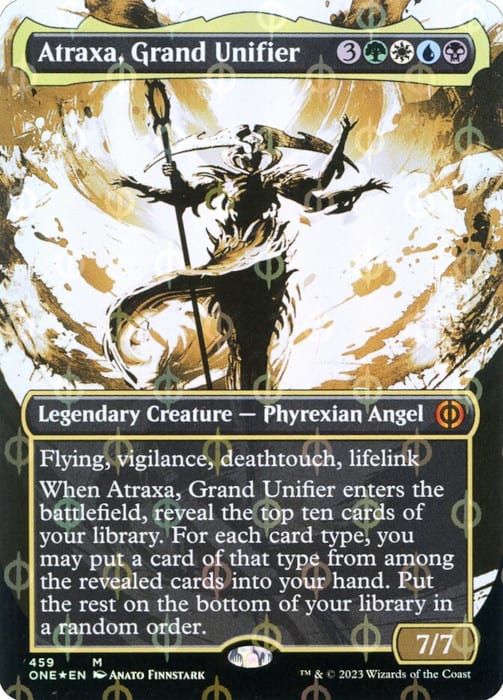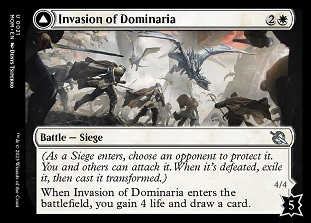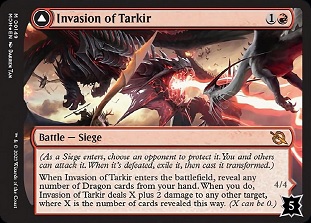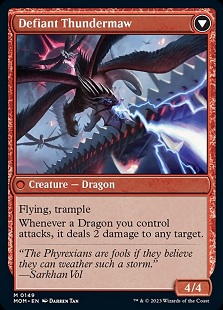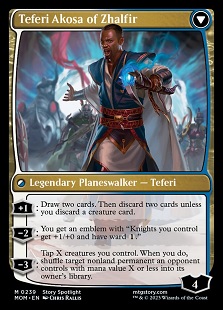Oh Atraxa, Grand Unifier, how you tease!
When Atraxa, Grand Unifier was previewed in Phyrexia: All Will Be One, there was a lot to look at. Already a very popular character, this new Mythic rare was four colors packed full of keywords and an absurd card draw ability, but also a little something else...
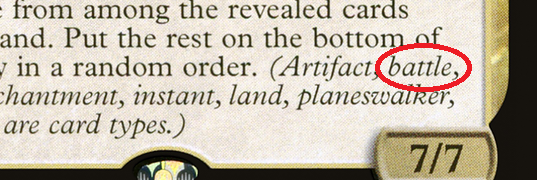
I'm sorry what now?
Much like how the original printing of Tarmogoyf would tease the introduction of the tribal card type, in true Marvel post-credits scene fashion Atraxa does the same for the new battle card type. Well now the March of the Machine previews have started, and we've gotten a look at a number of battle cards as well as information on how this card type works, so let's dive in!
Time To Battle
Unlike tribal, which feels more like a supertype than an actual card type, battle is a brand new type of card and permanent with it's own complete set of rules. Frankly, it's a lot to take in at first, so let's take a look!
These first battles we are seeing in March of the Machine have the subtype "siege," of which the rules text reads as follows:
In a lot of ways, these battle cards play sort of like reverse-planeswalkers. Rather than casting a card that will aid you that you need to protect that your opponent can attack, you are casting a card that your opponent needs to protect. This is super interesting gameplay-wise because of how you're altering your opponent's plans for the game - some decks just aren't meant to try and defend a permanent or produce good blockers and this puts them in a nice squeeze.
The number on the bottom right of the battle is its defense counters, which act almost the same as loyalty counters on a planeswalker. When you successfully attack a battle it will take damage just like a planeswalker, and you can also target and damage battles with things like Lightning Bolt that specify "any target" also, just like planeswalkers.
So far, all of the battles previewed have some sort of enters the battlefield effect on the front side, which acts sort of like a sorcery that then creates this altered game state where your opponent now has this position they must defend. For Invasion of Dominaria // Serra Faithkeeper you get a solid but unexciting four life and a card for three mana. So, why must they defend it? Because if you are able remove all of the defense counters on the battle and destroy it, it triggers and allows you to cast it flipped for free, giving you Serra Faithkeeper!
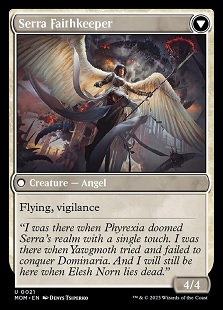
Now that three mana doesn't look so bad!
Now dealing five successful damage isn't always an easy task, but that's basically the flow of these battle so far. The front side is typically an at or slightly blow rate sorcery-type spell, with the bonus of the backside looming for serious value if you can pull it off.
Let's look at some of the more exciting ones.
Getting some really strong Bonecrusher Giant vibes here!
Sure, two mana for a Shock isn't that exciting, but as Bonecrusher Giant has shown us, as long as you're getting extra value as well it can be an excellent tool to make sure you don't fall behind in the early game as well as give you a big boost in the midgame as you have extra threats to work with. Obviously having some dragons in your deck can appreciably improve this effect, but even at two damage this is perfectly serviceable.
However, when you flip this bad boy you are getting something a little bit better than Bonecrusher Giant. Defiant Thundermaw is a huge, must answer threat, that like the front side gets better if you're playing more dragons but doesn't need to be surrounded by them to be good.
This is a pretty exciting one.
Lastly let's check out the major story beat Invasion of New Phyrexia, which has the distinction of flipping over into a planeswalker, which is quite exciting.
On the front side, Invasion of New Phyrexia // Teferi Akosa of Zhalfir is interesting for a number of reasons. Making 2/2 tokens with vigilance at a rate of one token for three mana, two tokens for four mana, three tokens for five mana, etc is honestly quite good, allowing you play both offense and defense as well as put a bunch of material in play as the game goes on. Furthermore, this is the only battle we've seen so far that can actually help itself win the battle! At X=3, your knights threaten to destroy the battle the turn immediately following the casting of this spell, which is great.
And once you flip it? You get a new Teferi planeswalker in Teferi Akosa of Zhalfir.
This Teferi is a little different than our usual control Teferis, providing you card draw if you're playing creatures, potential global pump effects, as the ability to use your creatures as a powerful removal spell. All three of these effects play very well with the front side, and the front side plays very well with creatures in general, making this card feel like the complete package. Put simply, there's a lot going on with this card!
Aside from the specific cards themselves, I think there are three important factors at work that must be considered when evaluating battles in March of the Machine:
They're More Than The Sum Of Their Parts
The comparison to adventure cards like Bonecrusher Giant or Lovestruck Beast is a great one, as it's the confluence of both sides of the card coming together than makes them excellent. Just Stomp or Heart's Desire would never be playable by themselves, and the creature parts of Bonecrusher Giant and Lovestruck Beast are passable but very unexciting. However, when you put the two together, you're now getting a lot of value for just one piece of cardboard.
These battle cards will be similar, and while evaluating what the front half does is going to be the much more important part of the pair, even the threat of the leftover value of the potential backside is going to change how games play out.
They Are Going To Be Difficult To Flip
The backsides to these are quite exciting when you think about them as a bonus on top of already reasonable frontside effects, but don't slip into the notion of thinking that flipping these is going to be easy. Many of the them have reasonably high defense numbers, and you're just not always in a spot where you have profitable attacks, especially in the face of counter attacks.
They also have the interesting tension of being potentially snowbally and good while your ahead, but also giving your opponent more time and life to work with and come back because you're specifically not attacking them.
They Will Prioritize Playing To The Board
Modern-day Magic in the last five or ten years has been drastically focused on playing to the board. Planeswalkers are a huge part of this, but the cards are also so powerful now that you want to press an advantage when you have it and be able to dig out of it when you don't. Many of the best cards of recent eras play to this, like Fable of the Mirror-Breaker // Reflection of Kiki-Jiki, Esika's Chariot, Nissa, Who Shakes the World, Gideon, Ally of Zendikar, Mantis Rider, and so on; they all share the common theme of helping to put you ahead on board, often while effecting the opponent's board or ability to attack as well.
Battles are huge in this respect, because they force even players who aren't that interested in the board like Control or Combo decks to all of the sudden have this on-board presence they need to protect, which is awesome.
Win The Battle, Win The War
First impression? The new battle card type and siege mechanic both seem awesome.
Forcing your opponent into action while also making both players care about different and unique things during a game is fantastic game design, and I can only hope these play as well as they look!
















